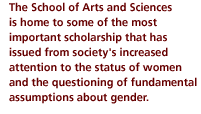
Dean's Column
By Dean Samuel H. Preston
Opportunity for All
 At
the end of the 1960s, I was a newly minted assistant professor at the
University of California at Berkeley. At my first
committee meeting to decide who would be admitted to the department’s
graduate program, we came to consider the application of a highly qualified
woman. In our deliberations, one of the senior faculty remarked, “Of
course, if a man and a woman have the same qualifications, you would always
accept the man because the woman is likely to get married, have children,
and leave the profession.” So conventional was the understanding
that his equally senior colleague acceded without a quibble, despite the
fact that she was a woman.
At
the end of the 1960s, I was a newly minted assistant professor at the
University of California at Berkeley. At my first
committee meeting to decide who would be admitted to the department’s
graduate program, we came to consider the application of a highly qualified
woman. In our deliberations, one of the senior faculty remarked, “Of
course, if a man and a woman have the same qualifications, you would always
accept the man because the woman is likely to get married, have children,
and leave the profession.” So conventional was the understanding
that his equally senior colleague acceded without a quibble, despite the
fact that she was a woman.
The National Organization for Women was only a few years old, and America was in the throes of a social revolution, spearheaded by a loose amalgam of groups and individuals called the women’s liberation movement. The political action of media-savvy protestors had sensitized much of the population to centuries of gender discrimination, and new expressions such as sexism, male chauvinism, consciousness raising, and Ms. had made their way into the popular lexicon. Berkeley may have been a hotbed of radicalism at that time, but a long-standing bias against women undertaking graduate study persisted.
 Today
at Penn, women count among the most outstanding graduate students and
faculty members in the School of Arts and Sciences. Our admissions committees
and faculty-search committees are scrupulous in seeking out the most qualified
people, regardless of gender. For over a decade, the proportion of women
on the standing faculty has been steadily on the rise: from just over
14 percent in 1987 to almost 24 percent in 2001. The rate of promotion
for men and women is nearly identical now. For faculty appointed between
1984 and 1992—those who have completed their tenure probationary
period—just over 50 percent of women and men alike went on to receive
tenure. Recruiting, retaining, and nurturing women faculty remains a high
priority.
Today
at Penn, women count among the most outstanding graduate students and
faculty members in the School of Arts and Sciences. Our admissions committees
and faculty-search committees are scrupulous in seeking out the most qualified
people, regardless of gender. For over a decade, the proportion of women
on the standing faculty has been steadily on the rise: from just over
14 percent in 1987 to almost 24 percent in 2001. The rate of promotion
for men and women is nearly identical now. For faculty appointed between
1984 and 1992—those who have completed their tenure probationary
period—just over 50 percent of women and men alike went on to receive
tenure. Recruiting, retaining, and nurturing women faculty remains a high
priority.
The School of Arts and Sciences is home to some of the most important scholarship that has issued from society’s increased attention to the status of women and the questioning of fundamental assumptions about gender. Leading scholars on gender relations and the multiple roles of women extend from Kathy Brown, who is an expert in colonial American history, to Ann Farnsworth-Alvear, a historian of Latin America, to sociologist Jerry Jacobs, who studies the contemporary U.S.
In many of the humanities disciplines, SAS has established a reputation for feminist scholarship. Phyllis Rackin, one of the nation’s preeminent scholars of English Renaissance literature, has studied Shakespeare’s attitudes toward women by examining female roles in his history plays. Nina Auerbach has done important work on women in English literature of the Victorian period. Liliane Weissberg, in the German department, has written about eminent women intellectuals like Hannah Arendt. All of these teacher-scholars are affiliated with the Women’s Studies program, which is one of the nation’s oldest.
There are far more opportunities for women in academia today and almost everywhere else in this country. The remark of my senior colleagues at Berkeley would no longer slip by unnoticed or unquestioned, but would be quickly challenged as benighted at best—downright foolhardy at worst. I hope the talented young woman who was rejected there in the late 60s went on to find opportunity elsewhere. Ben Franklin’s vision of an institution to promote the advancement of knowledge and the education of youth is blind in our day to the gender of anyone who shares that vision. Those committed to excellence in teaching and learning, research and service will find opportunity—and a home—in the School of Arts and Sciences at Penn.